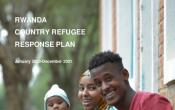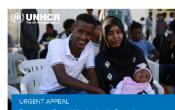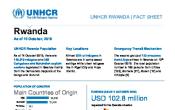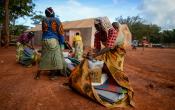Rwanda
Operation: Rwanda
Location
{"longitude":30,"latitude":-2,"zoom_level":8,"iso_codes":"'RWA'"}
By clicking on the icons on the map, additional information is displayed.
The boundaries and names shown and the designations used on this map do not imply official endorsement or acceptance by the United Nations.
Key Figures
| 2019 year-end results | |
| 100% | of refugees were individually registered. |
| 100% | of refugees received food assistance. |
| 100% | of children under 12 months were issued with birth certificates. |
| 90% | of people of concern had access to primary health care. |
| 90% | of school-age refugee children were enrolled in the national education system. |
| 2.7% | was the Global Acute Malnutrition rate. |
| 2020 planning figures | |
| 100% | of households provided with adequate shelter |
| 100% | of primary school-aged children will be enrolled in primary education |
| 100% | refugees and asylum-seekers in urban centers and camps will be registered on an individual basis |
| 60% | of refugees and asylum-seekers from Burundi and DRC living in urban areas and refugee camps will receive business/livelihood support |
| 0.3% | mortality rate for under 5-year-old children attained |
| 20,000 | Rwandan refugee returnees will be provided with basic assistance and supported to a safe and dignified integration |
| 20 | liters of potable water per person per day will be provided |
Latest Updates and Related Links
People of Concern
0%
Increase in
2019
2019
| 2019 | 153,025 |
| 2018 | 152,597 |
| 2017 | 191,392 |

[["Refugees",145057],["Asylum-seekers",495],["Returned refugees",2149],["Others of concern",5324]]
Loading ...
Rwanda
< Back
2019
{"categories":[2015,2016,2017,2018,2019,2020],"budget":[123.04000345,101.21378467,104.378181188,98.77603889,102.75124387,108.96196515],"expenditure":[39.48045656,44.64500707,42.13502654,35.33416822,41.84664384,null]}
{"categories":[2015,2016,2017,2018,2019,2020],"p1":[122.417859367,95.18270004,96.813086748,95.47573026,100.10124411,106.31196517],"p2":[null,null,null,null,null,null],"p3":[0.622144083,6.03108463,7.56509444,3.30030863,2.64999976,2.64999998],"p4":[null,null,null,null,null,null]}
{"categories":[2015,2016,2017,2018,2019,2020],"p1":[38.96277319,43.36483925,38.24165204,33.15910884,40.43048354,null],"p2":[null,null,null,null,null,null],"p3":[0.51768337,1.28016782,3.8933745,2.17505938,1.4161603,null],"p4":[null,null,null,null,null,null]}
Loading ...
CHOOSE A YEAR
- 2014
- 2015
- 2016
- 2017
- 2018
- 2019
- 2020
Operational context
Rwanda has been welcoming refugees for over two decades and continued to receive new arrivals in 2019, providing a favourable protection environment supported by its national legal framework.Since the Leaders’ Summit in 2016 and the adoption of the Comprehensive Refugee Response Framework (CRRF) in early 2018, the Government of Rwanda has promoted the integration of refugees within the scope of four commitments on documentation, socio-economic inclusion, and integration in national education and health systems. During the Global Refugee Forum in December 2019, the Government renewed pledges in these four areas and made a new commitment relating to energy and environmental preservation.
Following the conclusion of a tripartite agreement between the Government, the African Union and UNHCR in September 2019 establishing an Emergency Transit Mechanism (ETM), over 300 refugees and asylum-seekers were evacuated from Libya to Rwanda.
Population trends
In 2019, Rwanda hosted some 145,000 refugees, mainly from Burundi and the Democratic Republic of the Congo (DRC). This included some 2,700 individuals who arrived during the course of the year. Women and children represented 75% of the population.In 2019, some 2,100 Rwandan refugees chose to return home from the eastern part of the DRC.
Key achievements
- The Misizi marshland project improved the food security, social cohesion and income of more than 1,400 refugee and host community farmers.
- Urban refugees were able to access the national health insurance system.
- All camps shifted to clean energy cooking.
- Establishment of an ETM in Rwanda.
Unmet needs
With the operation only 41% funded for 2019, the level of assistance and protection services was consequently limited.- Only 50% of survivors of sexual and gender-based violence (SGBV) among Burundian refugees had access to adequate support.
- Among Congolese refugees, only 58% of women-headed households in camps had access to adequate shelter.
- Clean water supply was below standards in three camps (at an average of 13.8 litres per person per day as compared to the standard of 20 litres per person per day).
- There was a lack of school facilities (90 students per classroom).
- There were recurrent challenges in maintaining the provision of food assistance.
- Land scarcity resulted in the congestion of refugee camps and limited opportunities for agricultural projects.
- There was reduced support for self-reliance activities, with under 17,000 refugees engaged in income-generating activities during the year.
- There were reduced environmental intervention activities.
Working environment
While Rwanda remains politically stable, the Great Lakes region continues to be characterised by security issues and a political volatility, leading to a potential influx of refugees and asylum-seekers to Rwanda. Rwanda hosts refugees from Burundi and the Democratic Republic of the Congo, and additionally is receiving thousands of returnees each year from other countries in the region. Rwanda has maintained its open borders and the majority of refugees are recognised on a prima facie basis. The Government also provides land, a scarce asset, to house refugees in six camps and reception and transit centres across the country. Efforts to integrate refugees into national social services are under way and advanced in some areas, such as education, whereas healthcare remains largely inaccessible. Refugees enjoy a legal access to the labour market, though efforts still need to be made to ensure this translates to reality.UNHCR’s long-term vision aims that by 2030 all refugees, including potential new influx, will be living safe, dignified and productive lives across Rwanda outside of camps and supported by government-led services and programmes. This is aligned with the inclusive 2030 Agenda for Sustainable Development. UNHCR implemented a five-year multi-year, multi-partner (MYMP) strategy in 2018 to work towards this inclusion. In February 2018 the Government of Rwanda formally adopted the Comprehensive Refugee Response Framework, further bolstering its commitment to include refugees in its development planning.




























